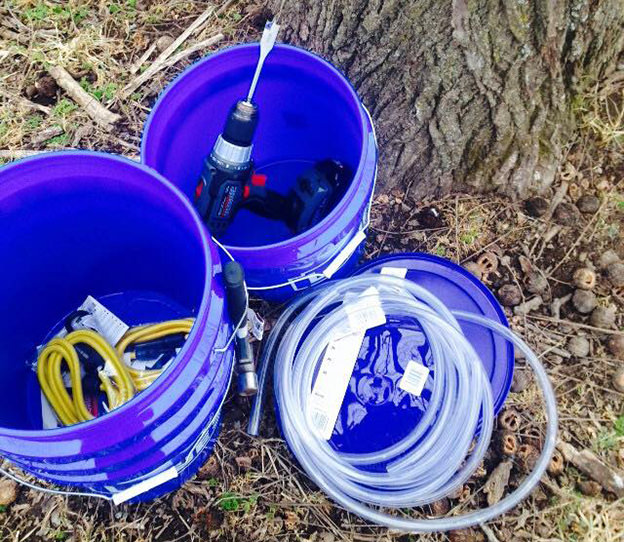
Maple trees aren’t the only sugar bushes that offer the prime ingredient for delicious syrup—sap can be tapped from birch, walnut, sycamore, boxelder and ironwood trees, as well. Where I live in Kentucky, we don’t have many sugar maples, but walnut trees are everywhere. The trees were once used for their nut crop or as a timber source to be cut down and sold to support a farmer’s retirement. Syrup tapping is rare in these parts, but when I came across several articles about tapping walnut trees for their sap, I knew I had to try it.
The weeks between Valentine’s Day and St. Patrick’s Day are supposed to be the most optimal time to tap black walnut trees in Kentucky. In general, ideal tapping temperatures are when the nights are freezing but the days are warm. Over the past two weeks, I’ve collected about 3 gallons of raw sap from a total of four trees.
The syrup is delicious, with a golden color and rich butterscotch flavor. My only problem with this experiment has been not having enough sap!
The walnut syrup seems perfectly designed to pair with Kentucky’s signature drink: bourbon. I’m curious to try it drizzled over cornbread, in a marinade for meat and as a glaze for roasted winter vegetables, though in all honestly, we’ve mainly been drinking it straight out of a small shot glass as a unique and delicious flavor experience to share with friends.
I need to find someone with a nice row of walnut trees lining their driveway so we can easily collect as much as possible. Now that March has begun, it may be too late to tap more trees this year, but I’ll be ready to try again next year. I can’t wait!
What You’ll Need

There are many ways to collect raw sap from a tree. Different types of taps, aka spiles, can be used, and collection systems can range from milk jugs to professional operations that use plastic tubing to connect a number of trees into a central sugar house.
Rather than ordering a metal spile online, I used a simple 1/2-inch plastic adaptor used for sprinkler systems (see photo), and it worked great. If you are trying to decrease the cost, you could use milk jugs instead of buckets.
The cost to set up a system on a single tree cost me about $7 to $8. All supplies were available from a local hardware store.
- 5-gallon food-grade bucket with lid
- length of 1/2-inch (interior diameter) non-toxic plastic tubing
- 1/2-inch plastic adaptor from the sprinkler section of the hardware store
- 3/4-inch drill bit
- bungees with hooks to secure the bucket to the tree
- battery-powered drill
- hammer
Step 1: Find Your Trees
The ideal tree is at least 10 inches or more in diameter. One of the nice things about walnut trees is that they are extremely easy to identify—even without leaves—because of all of the walnut shells surrounding the base of the tree!
Step 2: Put In The Tap

Use the 3/4-inch drill bit to drill a hole in the trunk of the tree. Your hole should be about 2 inches deep. Ideal height of the tap is about 2 to 3 feet high. Make sure to drill at a slightly upward angle. Use your hammer to tap the wide end of the plastic adaptor into your hole. Your tubing will attach to the narrow end.
Step 3: Attach Tubing and Bucket
Slide your tubing onto the adaptor. Use the 3/4-inch drill bit to make a hole in your bucket lid, making sure to clean any plastic shavings out of your collection bucket. Slide the tubing through the hole in the lid. Secure the bucket to the tree using the bungee cords.
Step 4: Make Syrup

Ideally your raw sap should be collected every day to prevent fermentation in warmer weather. Some days I gave myself a collection break if the outside temperature was 35 degrees F or colder. Once collected, I strained the raw sap into a pot and boiled it down on low heat for several hours until I had the ideal flavor and amount of syrup.
What Doesn’t Work
A slow cooker does not work well to boil down the sap because even with the lid cracked, there isn’t enough heat to boil the raw sap into syrup. If you have a large walk-in fridge where you can store a bucket, you might want to collect enough raw sap over the course of several days and store it in the fridge, so that you can end up with more syrup at one time.
My Experience Tapping Walnut Trees
My first day of walnut sap collection was really amazing. Between two trees, I got about 2 gallons, with one tree being much more of a gusher than the other. I’ve found the yield to vary among trees. Unfortunately, after the first day, my yields of raw sap dropped considerably, getting about 50 or 60 ounces of raw sap total per day from four trees. One tree has not produced at all while another produces almost double what the other trees produce. The trees are all at least 4 feet in diameter.
A ratio of 20:1—meaning 20 ounces of raw sap boiled to 1 ounce of syrup—was best to make a delicious golden elixir that tasted like a butterscotch maple drink. When I boiled down the sap to a 40:1 ratio, the taste was extremely sweet and the liquid was a white, cloudy color full of sugar particles. I preferred the flavor of the 20:1 ratio syrup, because it was richer and more complex. Don’t expect a sticky consistency to the final syrup—it’s sweet but still very liquid.




